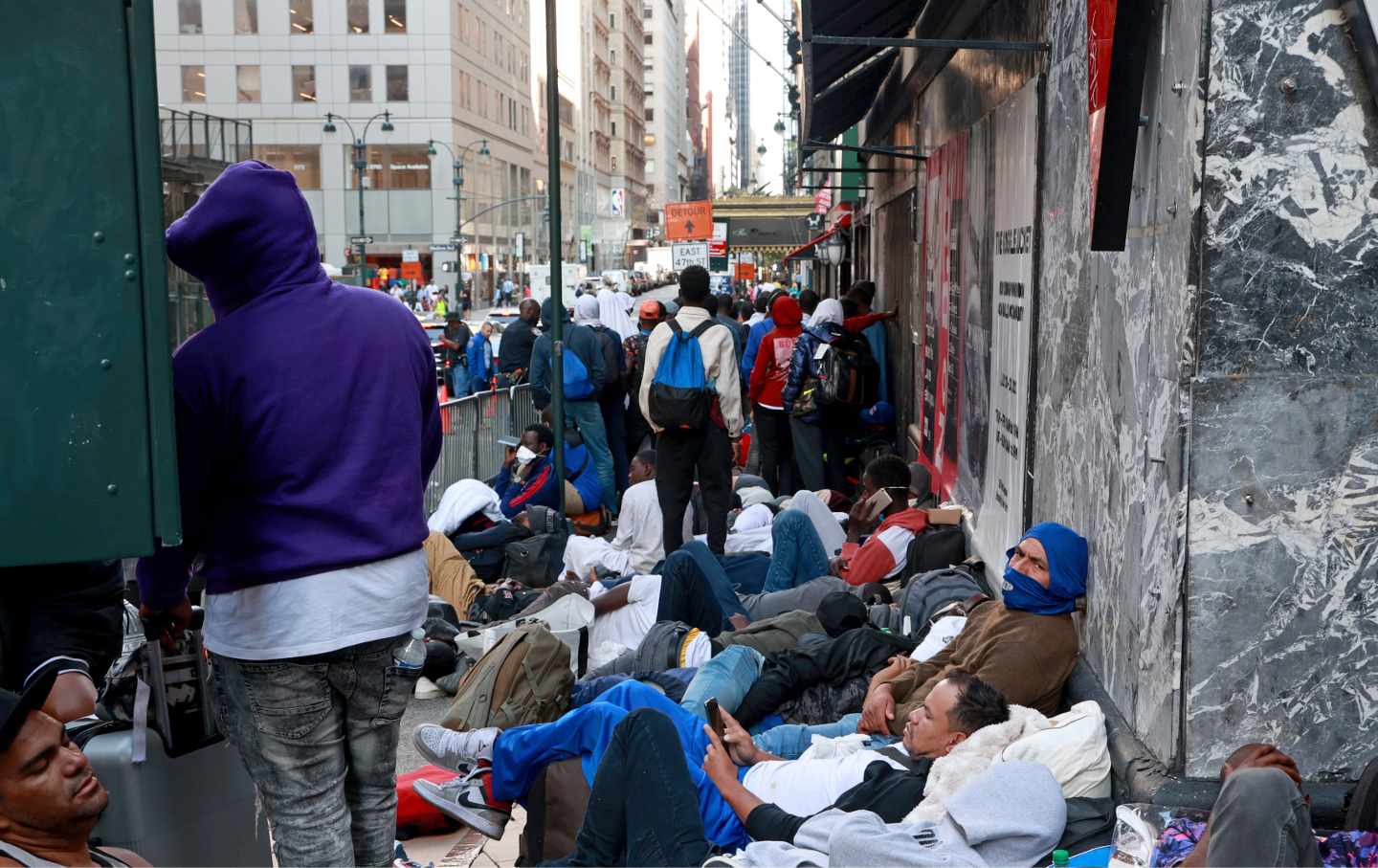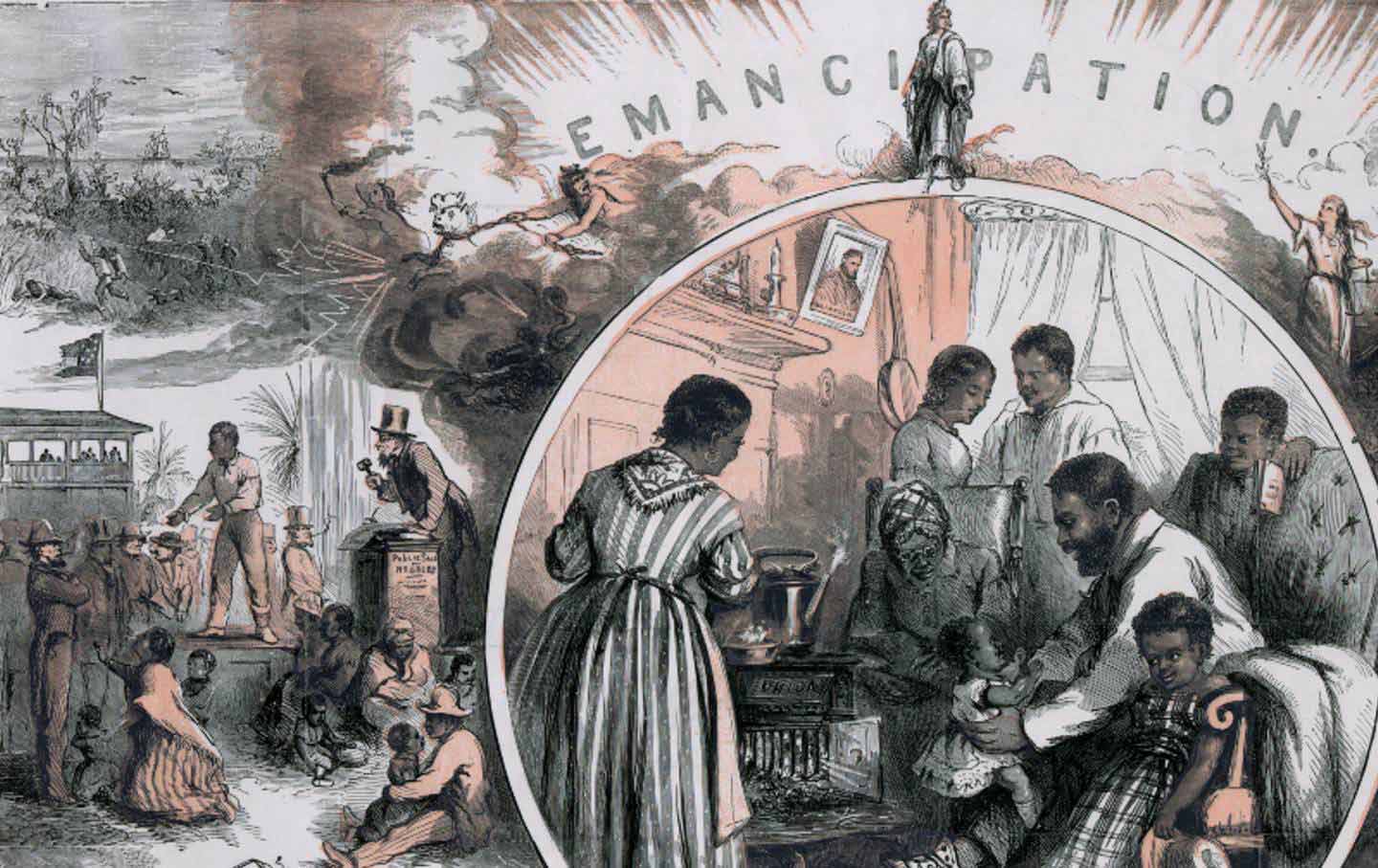“We Have to Wait. There’s Nothing Else We Can Do.”
What it was like for the migrants forced to sleep on the street in New York City.

Hundreds of migrants are seen outside the Roosevelt Hotel in Midtown Manhattan early Wednesday, August 2, 2023.
(Luiz C. Ribeiro for NY Daily News via Getty Images)Last week, over 150 migrants were forced to sleep on the street in the heart of Manhattan, outside New York City’s asylum intake center at the Roosevelt Hotel on 45th Street. They had been bused in from Texas along with many thousands of others. But despite being entitled to housing overnight by the city’s long-standing right to shelter law, they had been all but abandoned here. Mayor Eric Adams, who has said that the city is being “destroyed” by the arrival of the migrants and called the lack of accommodations for asylum seekers “inevitable,” is now challenging in court their right to shelter.
When I went to the Roosevelt on Wednesday, there were at least 100 people on the street. Cardboard boxes were arranged on sidewalks as makeshift sleeping mats. People had to wait for ages to charge their phones at the one available outlet on the block. Some had told reporters that the building wouldn’t let them in to use the bathroom, forcing them to go to Grand Central Station, several blocks away.
The people I spoke to had arrived in the United States from all over: Venezuela, Colombia, Mauritania. Others were from places like Peru and Senegal. Some said they had survived considerable peril, such as dangerous routes, border patrols, and detention center “iceboxes.”
As the asylum seekers waited, they said that they had been given no updates about how long they would be on the street, where they would be brought next, or how those decisions were being made. Volunteers from community and mutual aid groups said that they had been helping people on the sidewalk for over a week. One man from Mauritania said that he had been on the street for 10 days.
“They haven’t given us any information,” said Alquino, who told me he had been waiting to register for shelter for four days. “We have to wait. There’s nothing else we can do.” He had come to New York from Venezuela—passing through eight countries during three-and-a-half grueling months of travel—because he heard the city “helped migrants.” Now, he lay with his head resting on a metal fence, deflated.
Every so often, staff from the intake site—which is managed by DocGo, a medical services firm controversially subcontracted by the city—emerged from the hotel with food: sandwiches, bananas, Ziploc bags with cheese puffs, water. Mutual aid groups brought meals too—often pizza—and migrants used the empty boxes to block their faces from the onslaught of media and passersby. One woman filmed two men who shielded their faces from her phone camera. When an onlooker protested that they clearly didn’t want to be recorded, a police officer affirmed that the woman had a right to document; this was a public space. Minutes later, though, police approached me and a photographer, informed us we were blocking traffic, and instructed us to move out of the way. When two advocates with the ACLU approached a security guard at the hotel’s gilded entrance with questions about housing, they were similarly told to leave.
By Wednesday evening, it was clear that there wasn’t only a lack of information—there was also a refusal to share what little information there was. (A dislike of transparency appears to be the norm; a New York Times reporter in Albany recently watched a DocGo security guard threaten migrants for talking to the press.) I asked the driver of an out-of-service city bus filled with immigrant families where the bus was going; she responded by shaking her finger. “You can’t tell me where it’s going?” No again.
That night, when reporters had left and Midtown was as dark as it ever gets, dozens of migrants were bused from the line outside the Roosevelt to a church in Queens, according to multiple migrants I spoke to. There, they said, they had few outlets, no beds, and no WiFi—a problem, since many communicate using WhatsApp—but were at least given thin sleeping mats, blankets, and a roof over their heads. Other asylum seekers had been left behind on the sidewalk that night—including women traveling alone and folks seeking to stay with family.
Jhon Andersson Fajardo was in the latter category, hoping to be reunited with his cousins and their kids at the Watson, another hotel-turned-asylum shelter in Manhattan. His request was denied. On Thursday morning, Fajardo said he was being driven to a police academy in Brooklyn, without having been told why by DocGo staff—and fearing the worst. (The police academy, as it turns out, had become a temporary shelter.) In the end, Jhon was actually brought to stay at a school in Staten Island, where he was assigned one of dozens of cots in its crowded gym. “I need to take a shower, change my clothes—but I don’t have any clothes other than what I have on,” he texted in Spanish. “I want to eat something warm…. conditions are bad here.”
Across the city—and the state—when migrants have made it to shelters, conditions have too often been subpar. One center, in Bushwick, was still under construction when asylum seekers were moved in. “There [was] no finished flooring, no finished walls, it [was] really dusty,” Jon Caceres, who visited the site with South Bronx Mutual Aid, said. “They [were] cramped inside—it look[ed] like a detention center, because it [was] just cots lined up. Rows and rows of cots.”
At another Brooklyn shelter, migrants described sharing two bathrooms between 80 to 90 people, and said they didn’t receive enough food. In Albany—where asylum seekers in the city were shuttled by DocGo in May—they were threatened and given seemingly falsified documents.
Popular
“swipe left below to view more authors”Swipe →Joshua Goldfein, a staff attorney with the Legal Aid Society, sees poor conditions as connected to the city’s rush. “They’ve been moving very quickly to avoid scenes like the Roosevelt, so as soon as they have access to a space, they make use of it,” he told The Nation. The result is overcrowded spaces, constant reshuffling, and dire conditions. From Staten Island, Fajardo messaged: “I’m suspicious of this place, I don’t like it and I feel uncomfortable with so much police force here. Please help me. [I want to be] in Manhattan, closer to my family. I want to be able to work there.” (This Tuesday, he told me that he might soon be moved again. “They’re going to move us arbitrarily and send us much farther away,” he said. “They’ve already filled two buses of single men and I heard they’re sending us to Long Island.”)
Migrants are no longer sleeping outside the Roosevelt, but Goldfein told me that in a court meeting last Friday, the city did not guarantee they would not have to sleep on the street again. (The Mayor’s Office of Immigrant Affairs declined to comment on the situation, and the city’s press office did not respond to a request for comment.)
Should asylum seekers be forced to sleep outside, Goldfein will return to court. And in the meantime, he’s been going to the Roosevelt twice a day, to observe the situation. When I went back to the hotel the following Tuesday, nobody seemed to be sleeping outside; instead, they were housed in two spaces off Vanderbilt Avenue that were filled with rows of chairs instead of sleeping mats. During the day, people still wait outside to begin asylum applications.
Currently, work permits are granted only six months after migrants apply for asylum—a process that itself can take years. To circumvent that, advocates have been pushing for work authorization permits effective immediately. Adams, in a move that can best be understood as serving the financial interests of the city of New York, has pushed for expedited permits too—but without them being granted, he’s already announced single adult migrants will have just 60 days in shelters before needing to reapply.
Families, though prioritized for shelter, are also left in the dark about how soon they’ll be able to work, and how long they’ll be housed. Nuñez, who left Venezuela with her 4-year-old daughter to meet the little girl’s father—who was housed at a shelter in Brooklyn—has been staying in a room in the Roosevelt for a little over two months. “They still haven’t told us [how long we can stay], or if they’re going to move us somewhere else,” she told me last week. In Venezuela, she had worked as a machine operator at a purse factory while studying to be a nurse. “I’d like to finish my studies, if I have the opportunity. But I really don’t know what the process is, or if [I need] certain papers.”
She leaned on the facade of the Roosevelt, watching as her daughter played with the other kids on the block. Just around the corner, a new line of migrants was already beginning to form.
We cannot back down
We now confront a second Trump presidency.
There’s not a moment to lose. We must harness our fears, our grief, and yes, our anger, to resist the dangerous policies Donald Trump will unleash on our country. We rededicate ourselves to our role as journalists and writers of principle and conscience.
Today, we also steel ourselves for the fight ahead. It will demand a fearless spirit, an informed mind, wise analysis, and humane resistance. We face the enactment of Project 2025, a far-right supreme court, political authoritarianism, increasing inequality and record homelessness, a looming climate crisis, and conflicts abroad. The Nation will expose and propose, nurture investigative reporting, and stand together as a community to keep hope and possibility alive. The Nation’s work will continue—as it has in good and not-so-good times—to develop alternative ideas and visions, to deepen our mission of truth-telling and deep reporting, and to further solidarity in a nation divided.
Armed with a remarkable 160 years of bold, independent journalism, our mandate today remains the same as when abolitionists first founded The Nation—to uphold the principles of democracy and freedom, serve as a beacon through the darkest days of resistance, and to envision and struggle for a brighter future.
The day is dark, the forces arrayed are tenacious, but as the late Nation editorial board member Toni Morrison wrote “No! This is precisely the time when artists go to work. There is no time for despair, no place for self-pity, no need for silence, no room for fear. We speak, we write, we do language. That is how civilizations heal.”
I urge you to stand with The Nation and donate today.
Onwards,
Katrina vanden Heuvel
Editorial Director and Publisher, The Nation
More from The Nation

Mr. Scarborough Goes to Mar-a-Lago Mr. Scarborough Goes to Mar-a-Lago
The hosts of Joe Biden’s favorite political talk show have quickly pivoted to kissing the ring of the incoming president.

Watching a Parallel Media Try to Make Trump the Big Sports Story Watching a Parallel Media Try to Make Trump the Big Sports Story
The president-elect did not dominate the world of sports this weekend, but Fox News and Internet tabloids are inventing new realities.

The First Amendment Will Suffer Under Trump The First Amendment Will Suffer Under Trump
Given what’s heading our way, we need a capacious view and robust defense of the First Amendment from all quarters.

Slavery in an Age of Emancipation Slavery in an Age of Emancipation
Robin Blackburn’s sweeping history of slavery and freedom in the 19th century.

How Wisconsin Lost Control of the Strange Disease Killing Its Deer How Wisconsin Lost Control of the Strange Disease Killing Its Deer
Despite early containment efforts, chronic wasting disease has been allowed to run rampant in the state. That’s bad news for all of us.

The Prison Rodeo at the Heart of Legal Enslavement The Prison Rodeo at the Heart of Legal Enslavement
Angola prison workers make between 2 and 40 cents an hour. They also have a controversial outlet for recreation and to vend their wares at market rate: a rodeo.


